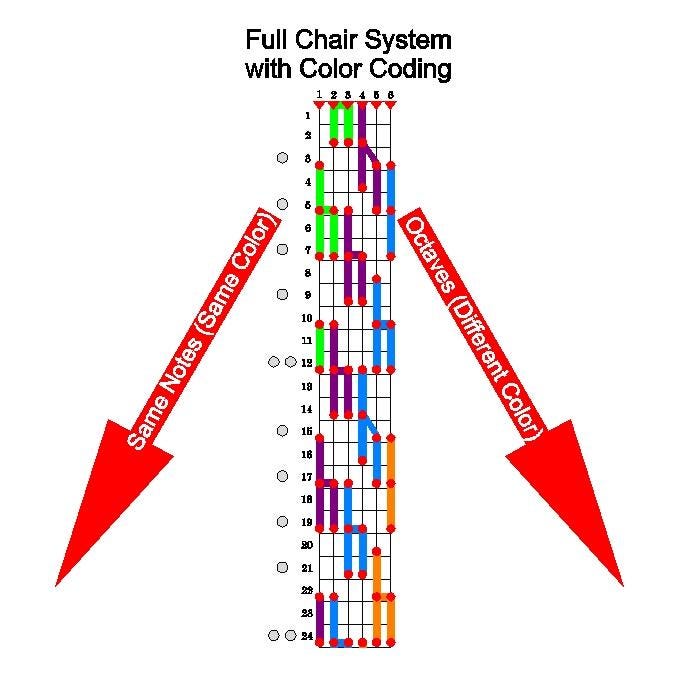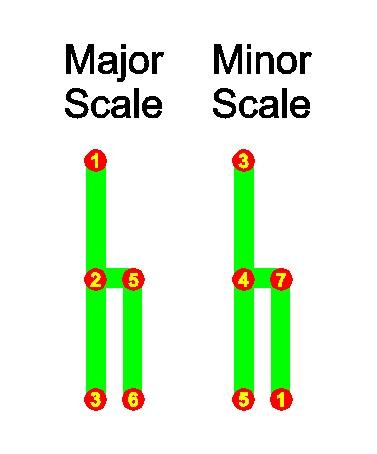Unboxing the Skeleton Key to Unbound Guitar Playing
A guest post from guitarist and educator Jeb Sherrill
Heya, it’s Scoob! I’m still in Japan, but Jeb has a third and final (for now!) guest post.
A quick note before I turn it over to Jeb. On the guitar, you can play most notes in three different places on the neck. I’m talking the exact same note. Not a different octave. Identical.
That creates a ton of options. Different pathways. Different shapes. In other words, there are so many viable ways to visualize the instrument. Guitar is a geometrically intricate thing. (So is saxophone by the way!)
And yes, I have my own way of looking at the instrument, distinct from the one outlined by Jeb in this post. But I’ve never systematized it! It’s just the way my brain works.
That said, I’m fascinated and excited by Jeb’s work, creating a new way to look at the fretboard. The beauty (and horror) of the guitar is in its flexibility. It’s deep. But shapes can make meaning and order out of the chaos! So I hope you enjoy the way Jeb views the instrument and the way he got to his system.
There’s no right way. But there are just the right ways for the right perspectives!
- Scoobert Doobert
—
Every guitarist has been there.
Even if we already play another instrument, the guitar is very simply strange.
When I was first trying to understand the fretboard, it felt like a nebulous puzzle I couldn’t solve. The repeating nature of frets and dots makes it seem erratic and chaotic… or perfectly structured if you look at it differently. Music theory is hidden in the structure if you approach it from a certain angle, but it took me many years to figure that out.
The Black Hole
Like most, I came to learn the first three frets, plus the nut pretty well. [Scoob’s note: The nut is a small piece of bone, plastic, graphite, etc, that keeps the strings in line on their way to the headstock. It’s the bit that enables us to play “open” strings.]
I figured out all the open chord shapes and even the first position of the E scale. But everything below those three frets was a black hole of nothingness.
But in reality, I didn’t even understand that first chunk of notes because I couldn’t visualize the overall pattern. It was all a black hole.

How It Began
Eventually, I was watching a Marty Schwartz video.
In it, he played a five-note scale (aka the pentatonic scale) but presented in a new way. It was an extended scale, meaning it went up and down the neck.
In this scale, I noticed a pattern, and when I drew one of those shapes out, by marking the five notes as dots and connecting the dots, I made a sideways chair!
This shape became the basis of the Chair System:
Seeing Patterns Everywhere
I may not be much of a guitarist, but I do have an affinity for patterns. Once I’d found the Chair pattern, it kept expanding. I found I could use it to play both in Major and Minor. Each successive chair contained notes from the next higher octave, so I could play the same lick in three different octaves and slide from one to the other without thinking.
The pattern repeated up and down the neck and into infinity like a DNA spiral moving around the fretboard. This formed a matrix of notes. I colored the chairs a different color for each octave.
Understanding Repeated Notes
I often heard, “There aren’t all that many notes on a guitar.” Before seeing the patterns, I didn’t get it. Now it was obvious.
Seeing the repeating colored chairs shifted how I looked at the instrument — it became more like a piano! A complicated piano, certainly, but now the notes could progress more like they did on a keyboard. And also, the notes could move in different directions, not just in sequence. They could move vertically, up and down each single string, horizontally from left to right, or diagonally from the top left corner to the bottom right corner.
Crossing Bridges
Further exploration showed the notes repeating from the top right to the bottom left. All the chairs could be connected with another repeatable shape made from a pair of one-and-a-half-step forms (three frets) I call Bridges.
Three frets beneath the front of any chair was the back of another and three frets beneath the back was another front. Above any chair was the same in reverse. After that, I didn’t have to see the notes in sequence because I could use the notes from all the chairs, and their connecting bridges, now that I understood their positions in relation to each other.
This wasn’t just breaking out of the box. This was more like, “There is no box.”
A Different Way to See the Fretboard
Keep in mind, these are all the same notes. The same scales.
The chairs are just a different way of looking at the grid:
This is where I started to see the pattern as more than a sequential scale because I could play the notes in any direction! They didn’t have to be played in order.
Patterns in Context
I found the CAGED system for Major and Minor in the pattern.
[Scoob’s note: The CAGED system is a pretty standard way of looking at the guitar fretboard, based around the familiar open chords: C, A, G, E, D. It’s another way of looking at the patterns that Jeb is finding here. Some critics of CAGED systems is that it’s too “boxy” or makes guitarists all play similarly and locked inside of a CAGE, haha.]
The chord shapes were all in the same places up and down the chair structure. This meant I could start seeing the overall pattern, the grid of notes, with scales and chords at the same time.
For instance, if I started with a G/Em chair, I could see the pentatonic scales and chords for both G and Em. Because each chair had the same notes in the same place, I could see the 1st, 2nd, 3rd, etc. everywhere on the fretboard.
It gave the grid of notes context.
Seeing Music Theory
I could have stopped there. All I really wanted was to play blues, and moving across the fretboard pentatonically was a breeze now. But my pattern brain kept running and I really couldn’t stop it:
I could now see music theory on the fretboard instead of just scale patterns. I watched tons of videos and read books about theory. I kept finding more and more information encoded in the chair system.
Getting into diatonic scales, I added two notes to every chair to get what I started calling the throne shape.
[Scoob’s note: Diatonic scales are seven-note scales — two more than the pentatonics. The most common diatonic scales are the Major and Minor scales. There are others with fun names like Locrian, but that’s just to help you win trivia night.]
I used that to find all the diatonic notes up and down the fretboard, and that really opened Pandora’s Box.
The Circle of Fifths
Using the Thrones to see the diatonic scale as a grid allows you to understand the context of all chords associated with both the Major and Minor roots, as well as the scales associated with any of those chords. It also reveals which notes of those scales fall outside the pattern. It’s basically like having the Circle of Fifths on the fretboard expressed as a series of Throne shapes.
Exotic Scales
I could also add and subtract notes from the Chair and Throne shapes. Add a note to the back leg of a Chair and you have the Hexatonic blue note. Shift one note in the Throne to get a Harmonic minor scale, or two to get a Melodic Minor scale. And because you can look at the Thrones as a grid, you can also start seeing all the different Modes in the pattern as well.
[Scoob’s notes: If you’re not a musician, don’t worry too much about this. Modes and “exotic” scales are widely used, but some pretty deep-end music theory stuff.]
The Skeleton Key
All this is a lot to digest, but I wanted everyone to have an overview of how the system works. You can use the Chairs to see the pentatonic scales for both Major and Minor, the CAGED system for both Major and Minor, and visualize the entire fretboard as a grid instead of sequential scales.
You can use the Thrones to create diatonic scales or a diatonic grid. You can modify the shapes for Hexatonic, Melodic or Harmonic minor, or modes. And you can use it to visualize the Circle of Fifths and see which chords can be used with the scales, create chord progressions, shift keys, or see all the chords associated with all the notes in a key including their respective CAGED systems.
Forget Theory
In short, it’s music theory imprinted in the fretboard. And what you can see, you can program into your fingers and then forget.
(Not completely forget. The knowledge is always there.) But it makes it so you don’t have to think about it once you have it down. It’s pretty amazing how good it feels to just close your eyes and let your fingers move.
What Can YOU Do With It?
I wish I had the Jazz sophistication or Progressive Rock understanding to fully use all of what I think this system can do.
[Scoob’s note: Next week’s post is on the history of prog rock!]
I don’t know if the Chair System will work for everyone. It probably works best for those whose brains process information in certain ways.
On the other hand, guitarists do tend to be pattern-minded, so perhaps it’s not surprising that so many seem to have already found it useful.
I hope you will as well!
Yours For Free
I’ve put out many videos and also some articles like this one to share what I’ve learned. I’m basically giving my system away for free because I think we should all be able to learn guitar in whatever way works best for us.
It’s difficult to understand the utility of such a system if people can’t see what it is and what it does. So many internet guitar teachers try to hook people into buying their systems sight unseen using ads and teasers. I don’t do that.
I do sell teaching aids, including diagrams and fretboard stickers, on my website in the hope of making a living, to some degree, off this concept. I’m also writing a book and working on a new video series.
But one way or another, it’s not mine — it’s yours. And I hope you enjoy it.
-Jeb
Now’s the time to venture forth and apply this system into your own version of something fresh! As Jeb mentioned, program through practice and then create thoughtless action. Or put another way, learn it to forget. Your flow state awaits.
If you want my take on this structural principle of creativity, give this past pod I did a listen on the balance between grasping and getting it:
—
For an accompanying chair system discussion on a complimentary medium make a note of Jeb’s upcoming appearance on the Love Music More podcast hosted by Scoobert Doobert and produced by Beformer on Tuesday October 29th. Music on!











